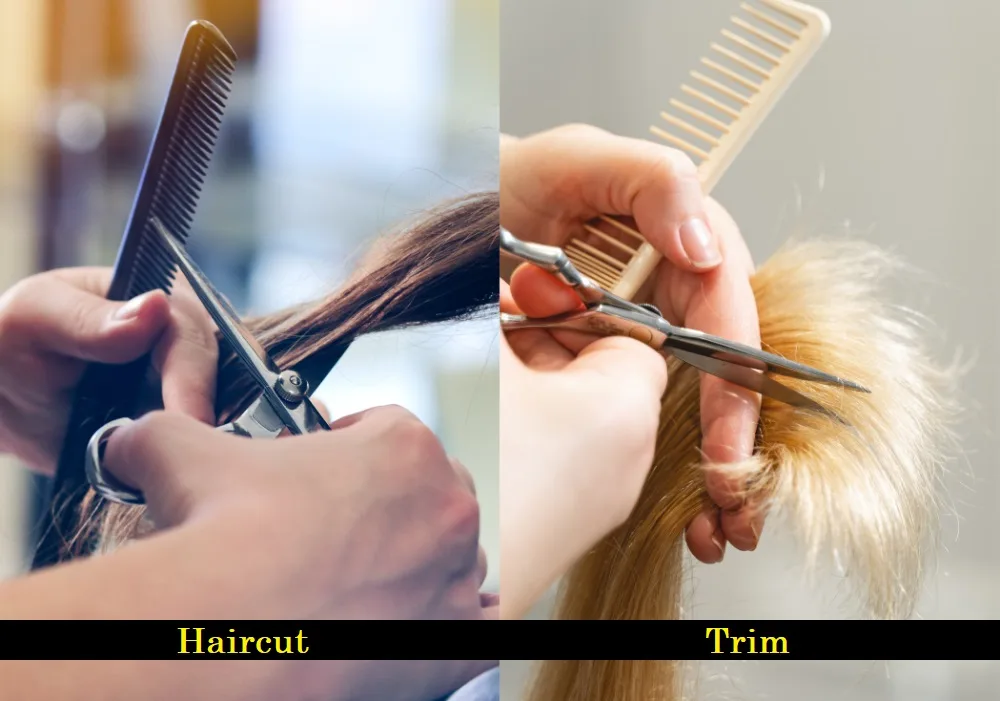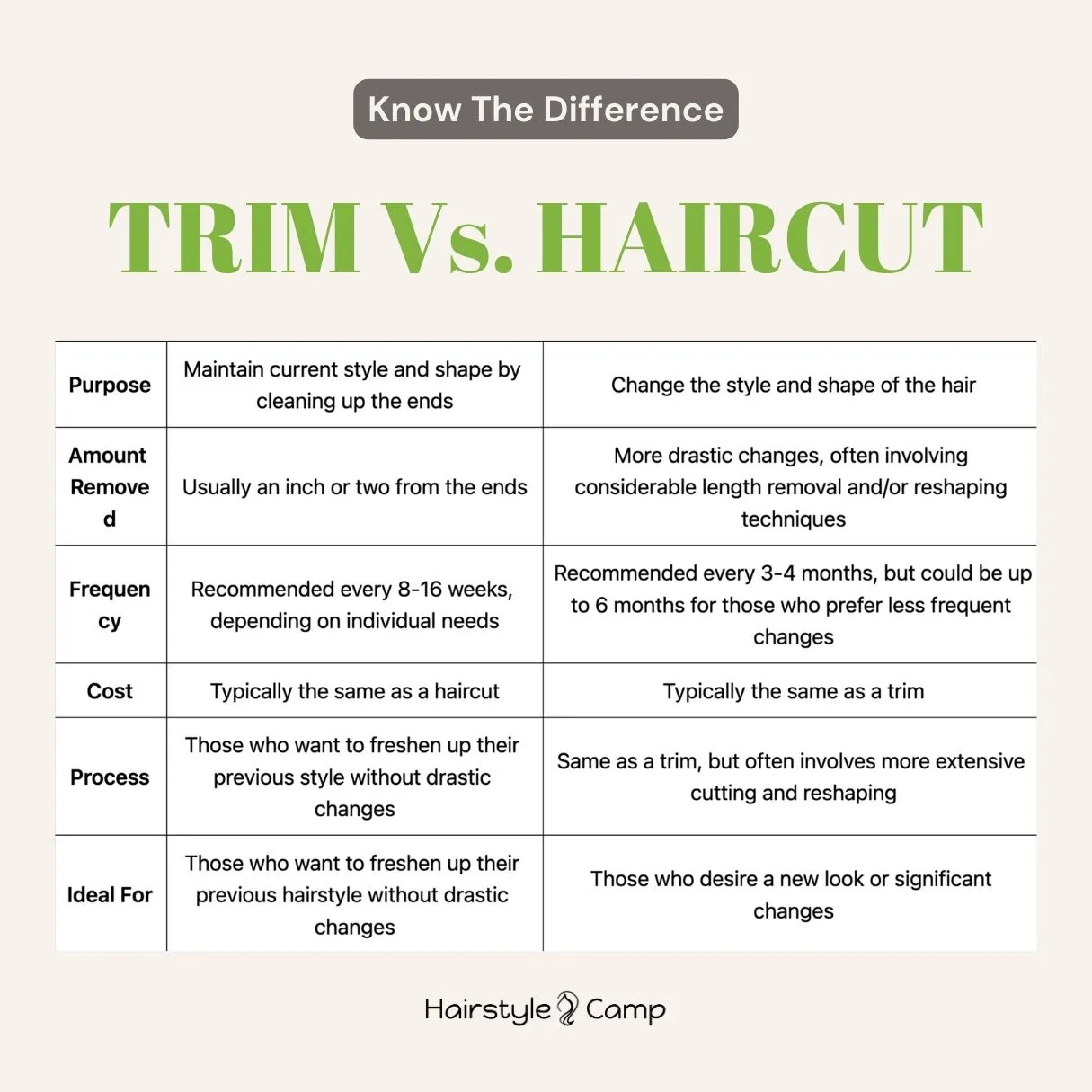Are you thinking of getting a trim haircut? Beware, don’t use the term ‘trim’ to mean any haircut. Most people think a “trim” is slang for a slight change to your hairstyle or any sort of haircut. But for professional hair stylists, a trim has a more specific meaning.
But what exactly is a trim? What’s the difference between a trim and a haircut?
Essentially, trimming your hair means maintaining the haircut you already have and cutting off the ends of your hair so that it stays healthy.
What Is a Trim Haircut?
A trim haircut refers to a minor haircut where only a small amount of hair is cut off. Typically, a trim involves cutting off split ends or damaged hair to maintain the existing hairstyle and promote healthier hair growth.

When you walk into a hair salon and ask for a trim, the stylist will understand that to mean three things:
- Only half an inch to two inches will be removed from the end of your hair.
- You will still have the same hairstyle or shape.
- All split and damaged hair, and thinning ends are to be removed.
If you are looking for a substantial change in your hairstyle, and you are using the word “trim” to mean any haircut, you could end up wasting money and walking away dissatisfied.
However, a trim haircut is important to preserving the health of your hair, but it’s not a full haircut.
Difference Between a Trim and a Haircut

Trim could be considered a haircut in the sense that the latter means your hairdresser will cut your hair. But when you get a haircut, you usually want to change your hair shape or style in some way.
Though they usually take the same time and the price tends to be the same, a full haircut requires removing much of the length of your hair, layering, or other reshaping techniques.
If the hairstyle you had has fully grown out or if you want a change, you will need a haircut. You should only ask for a trim if you want to maintain your current style and you only need to clean up the ends.
Here’s the summarized trim vs haircut comparison shown in tabular form:
| Trim | Haircut | |
|---|---|---|
| Purpose | Maintain current style and shape by cleaning up the ends | Change the style and shape of the hair |
| Amount Removed | Usually an inch or two from the ends | More drastic changes, often involving considerable length removal and/or reshaping techniques |
| Frequency | Recommended every 8-16 weeks, depending on individual needs | Recommended every 3-4 months, but could be up to 6 months for those who prefer less frequent changes |
| Cost | Typically the same as a haircut | Typically the same as a trim |
| Process | Those who want to freshen up their previous style without drastic changes | Same as a trim, but often involves more extensive cutting and reshaping |
| Ideal For | Those who want to freshen up their previous hairstyle without drastic changes | Those who desire a new look or significant changes |
Do You Need Your Hair Trimmed?

If you notice damage, thinning, or split ends yet want to keep your current overall hairstyle, you likely need your hair trimmed. Keeping your hair neatly trimmed offers a range of benefits.
Not everyone’s hair grows at the same rate, so people need trims at different times. If you’re not sure whether or not you need a trim, assess your hair for the tell-tale signs you need your hair trimmed below, and call your salon if your hair is telling you it’s tied for some upkeep.
Thinning Ends
Thin ends indicate hair damage that the conditioner won’t fix. You can slather on as many deep-conditioning treatments as you want, but you usually can’t revive dead ends, you need to chop them off.
Losing Layers
Hairstyles are often cut at different lengths to create a layered look. However, hair grows at different rates depending on where it is on the head. A quick trim will give your layered style new life.
Rough Texture
If your hair feels like straw fresh out of the shower, it’s time to chop off those brittle ends and keep the rest of your hair silky smooth. Even if your hair shaft is luscious and soft, the brittle straw-like ends will detract from your natural hair shine.
Frequent Knotting
Split ends tend to form tiny, single-strand knots in the shower. When this happens, it makes brushing your hair after the shower a tedious, painful task. A quick trim will streamline your showers for the next month.
It’s Been a While
Regular haircuts are more than a matter of style, they are essential for keeping your hair strong and healthy. It is recommended that you get a haircut every 6-8 weeks. If you don’t want to change your hairstyle that often, a simple trim will keep your hair looking great
Why You Should Get a Trim?
A trim is generally done to maintain the health and shape of the hair, without making any significant changes to the length or style. If you’re maintaining a specific style, routine trims can help your hair look neat and well-kept.
Here’s why you should get a regular trim:
- Promotes healthy growth by removing split ends.
- Prevents hair breakage and damage.
- Ensures hairstyle retains its shape.
- Refreshes your look and keeps your hair neat.
- Makes hair easier to style and manage.
- Reduces tangles and knots.
- Gives hair a fuller, more voluminous look.
Your hair is one of the first things people notice about you, and as they say, “there’s no second chance to make a first impression.” Your hair will take care of you as long as you take care of it, so here are five key reasons why you should get a trim for your hair regularly.
Removes Split Ends
The number one reason people get tri haircuts is to remove those unattractive split ends. Not only are split ends unappealing, but they create an unpleasant texture and make your hair more vulnerable.
Helps Hair Grow
This benefit is hotly debated, but most stylists and professionals agree that cutting your hair frequently can promote growth.
Reduces Heat Damage
As mentioned, split ends leave your hair vulnerable to damage, especially heat damage. If you frequently apply heat to your hair, whether a curler, straightener, or blow dryer, dead ends are more likely to experience heat damage than fresh cut ends.
Easier Styling
Brittle, dry hair can be uncooperative when trying to style it. You may notice that dead ends don’t hold a curl as well or look as attractive in an updo.
Creates Volume
Dead and frayed ends weigh your hair down, so it looks thinner and more stringy. But a trim can rejuvenate your hair, leaving the ends looking thicker and giving you the appearance of more hair.
How Often Should I Get a Trim?
Depending on your hair type and condition, I typically recommend that you get a trim every 6-8 weeks. The length you’ll want to trim can vary, but it’s often about an inch or less.
African hair, often curly and medium-thick, grows at a slow rate of 0.9 cm per month, needing a trim every 10-12 weeks. Caucasian hair grows at a rate of 1.2 cm per month, necessitating a trim every 8-10 weeks. Asian hair grows the fastest at 1.4 cm per month, leading to a trim recommendation every 6-8 weeks.
How Often Should You Get A Trim on Different Types of Hair?

Different types of hair need different types of care. That includes how often to get trim haircuts. While there are many categories you can use to discuss different hair types, such as straight, curly, thick, thin, etc., hair ethnicity will determine how often trims are necessary.
There are three main types of hair ethnicity. Many factors define the groups, including hair density, growth rate, follicle shape, and more.
African Hair
African hair is often curly with a medium thickness. It has a slow growth rate of 0.9 centimeters a month. If you have African hair, you can likely wait 10-12 weeks for a trim.
Caucasian hair
Caucasian hair falls in the middle, growing at a rate of 1.2 centimeters a month, requiring a trim every 8-10 weeks.
Asian Hair
Asian hair grows the fastest, at a rate of 1.4 centimeters a month. It’s thinner and lighter than other hair types, so you may grow long hair quickly. People with Asian hair should get a trim haircut every 6-8 weeks.
| Hair Type | Growth Rate per Month | Trim Frequency |
|---|---|---|
| African Hair | 0.9 cm | 10-12 weeks |
| Caucasian Hair | 1.2 cm | 8-10 weeks |
| Asian Hair | 1.4 cm | 6-8 weeks |
How Expensive Are Trim Haircuts?
A trim haircut is typically the cheapest type of haircut you can get at a salon. Expect to pay between $20 and $50 for just a trim. But at the fanciest salons, a simple hair trim could be as much as $100.
Some salons may charge more if your hair is super thick or curly, but $30 is the average price for everyone.
Final Thoughts

Trims may not be as fun or exciting as a total hair makeover, but they’re necessary for a healthy hair routine. If you can’t remember the last tie you got a trim, it’s time to call your salon so you can get your shiny, voluminous hair back.
